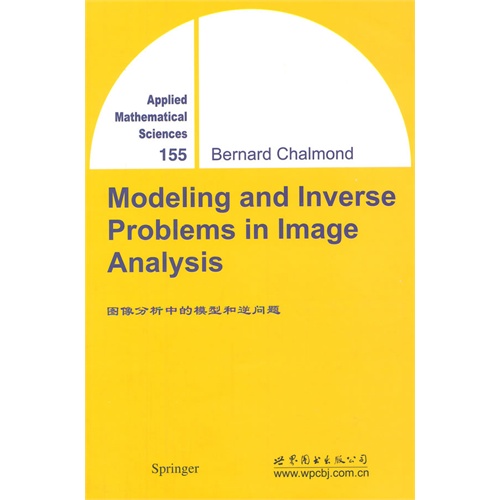
5分
包邮图像分析中的模型和逆问题

- ISBN:9787510070198
- 装帧:一般胶版纸
- 册数:暂无
- 重量:暂无
- 开本:24开
- 页数:309
- 出版时间:2014-11-01
- 条形码:9787510070198 ; 978-7-5100-7019-8
本书特色
this book fulfills a need in the field of computer science research and education. it is not intended for professional mathematicians, but it undoubtedly deals with applied mathematics. most of the expectations of the topic are fulfilled: precision, exactness, completeness, and excellent references to the original historical works. however, for the sake of read-ability, many demonstrations are omitted. it is not a book on practical image processing, of which so many abound, although all that it teaches is directly concerned with image analysis and image restoration. it is the perfect resource for any advanced scientist concerned with a better un-derstanding of the theoretical models underlying the methods that have efficiently solved numerous issues in robot vision and picture processing.
内容简介
《图像分析中的模型和逆问题》,本书是一部十分优秀的讲述成像分析中的贝叶斯成像和样条模型的教材。随着更多数学家在新兴学科数字成像数理中参与地越来越多,并且在解决复杂问题的模型建立方面扮演越来越重要的角色,做出的贡献也日益呈现。这本书出现显得尤为重要。本书更多地强调基于能量的模型,这些模型大多源于作者参与的机器人视野和X光线照相术,如追踪3D线、射线图像处理、3D重组和X线断层摄影术、等等的工业项目。读者对象:该书的目标读者是想学习更多在成像处理应用的数理统计人员和想要将数学知识应用于自身研究的工程人员。
目录
foreword by henri maitreacknowledgmentslist of figuresnotation and symbols1 introduction 1.1 about modeling 1.1.1 bayesian approach 1.1.2 inverse problem 1.1.3 energy-based formulation 1.1.4 models 1.2 structure of the book spline models2 nonparametrie spline models 2.1 definition 2.2 optimization 2.2.1 bending spline 2.2.2 spline under tension 2.2.3 robustness 2.3 bayesian interpretation 2.4 choice of regularization parameter 2.5 approximation using a surface 2.5.1 l-spline surface 2.5.2 quadratic energy 2.5.3 finite element optimization3 parametric spline models 3.1 representation on a basis of b-splines 3.1.1 approximation spline 3.1.2 construction of b-splines 3.2 extensions 3.2.1 multidimensional case 3.2.2 heteroscedasticity 3.3 high-dimensional splines 3.3.1 revealing directions 3.3.2 projection pursuit regression4 auto-associative models 4.1 analysis of multidimensional data 4.1.1 a classical approach 4.1.2 toward an alternative approach 4.2 auto-associative composite models 4.2.1 model and algorithm 4.2.2 properties 4.3 projection pursuit and spline smoothing 4.3.1 projection index 4.3.2 spline smoothing 4.4 illustrationⅱ markov models5 fundamental aspects 5.1 definitions 5.1.1 finite markov fields 5.1.2 gibbs fields 5.2 markov-gibbs equivalence 5.3 examples 5.3.1 bending energy 5.3.2 bernoulli energy 5.3.3 gaussian energy 5.4 consistency problem6 bayesian estimation 6.1 principle 6.2 cost functions 6.2.1 cost b-hnction examples 6.2.2 calculation problems7 simulation and optimization 7.1 simulation 7.1.1 homogeneous markov chain 7.1.2 metropolis dynamic 7.1.3 simulated gibbs distribution 7.2 stochastic optimization 7.3 probabilistic aspects 7.4 deterministic optimization 7.4.1 icm algorithm 7.4.2 relaxation algorithms8 parameter estimation 8.1 complete data 8.1.1 maximum likelihood 8.1.2 maximum pseudolikelihood 8.1.3 logistic estimation 8.2 incomplete data 8.2.1 maximum likelihood 8.2.2 gibbsian em algorithm 8.2.3 bayesian calibration ⅲ modeling in action9 model-building 9.1 multiple spline approximation 9.1.1 choice of data and image characteristics 9.1.2 definition of the hidden field 9.1.3 building an energy 9.2 markov modeling methodology 9.2.1 details for implementation10 degradation in imaging 10.1 denoising 10.1.1 models with explicit discontinuities 10.1.2 models with implicit discontinuities 10.2 deblurring 10.2.1 a particularly ill-posed problem 10.2.2 model with implicit discontinuities 10.3 scatter 10.3.1 direct problem 10.3.2 inverse problem 10.4 sensitivity functions and image fusion 10.4.1 a restoration problem 10.4.2 transfer function estimation 10.4.3 estimation of stained transfer function11 detection of filamentary entities 11.1 valley detection principle 11.1.1 definitions 11.1.2 bayes-markov formulation 11.2 building the prior energy 11.2.1 detection term 11.2.2 regularization term 11.3 optimization 11.4 extension to the case of an image pair12 reconstruction and projections 12.1 projection model 12.1.1 transmission tomography 12.1.2 emission tomography 12.2 regularized reconstruction 12.2.1 regularization with explicit discontinuities 12.2.2 three-dimensional reconstruction 12.3 reconstruction with a single view 12.3.1 generalized cylinder 12.3.2 training the deformations 12.3.3 reconstruction in the presence of occlusion13 matching 13.1 template and hidden outline 13.1.1 rigid transformations 13.1.2 spline model of a template 13.2 elastic deformations 13.2.1 continuous random fields 13.2.2 probabilistie aspectsreferencesauthor indexsubject index
作者简介
Bernard Chalmond是国际知名学者,在数学和物理学界享有盛誉。本书凝聚了作者多年科研和教学成果,适用于科研工作者、高校教师和研究生。
-

宇宙与人
¥13.0¥35.0 -

新太阳系
¥9.9¥35.0 -

世纪幽灵-走近量子纠缠
¥12.0¥28.0 -

物理学之美-插图珍藏版
¥27.6¥69.0 -

昆虫的生存之道
¥14.2¥38.0 -

为了人人晓得相对论
¥6.9¥13.5 -

技术史入门
¥17.4¥48.0 -

东京文艺地图(九品)
¥14.2¥38.0 -

假设的世界:一切不能想当然
¥19.1¥45.0 -

怎样解题
¥17.2¥29.0 -

118个数学竞赛不等式
¥45.5¥78.0 -

数学的魅力;初等数学概念演绎
¥12.5¥22.0 -

普林斯顿微积分读本-(修订版)
¥69.3¥99.0 -

130种美鸟彩图馆
¥17.1¥39.8 -

科学与现代性:整体科学理论
¥18.2¥33.0 -

模论
¥5.0¥3.6 -

运筹学原理与方法
¥24.0¥72.0 -

数学分析理论原理与方法时间探析
¥29.8¥90.0 -

刘薰宇的数学三书:原来数学可以这样学全3册
¥35.2¥118.0 -

趣味物理学问答
¥19.5¥46.0









